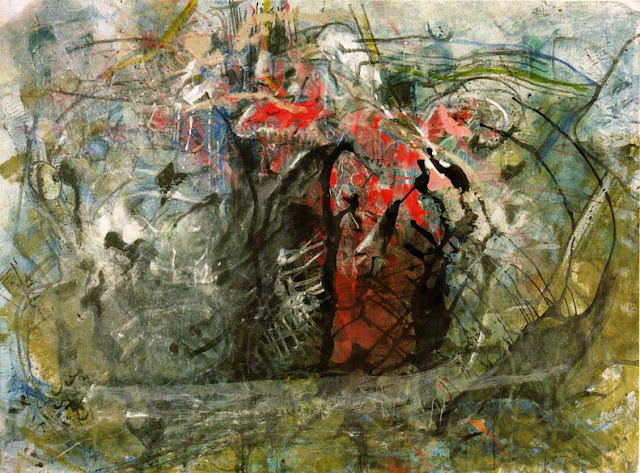Noland also studied Bauhaus theory and colour under Josef Albers, and he became interested in Paul Klee.
In 1948 – 1949 Noland worked with Ossip Zadkine in Paris, and had his first exhibition of paintings there. In the early 1950s he met Morris Louis in Washington DC. He became friends with Louis, and after being introduced by Clement Greenberg to Helen Frankenthaler and seeing her new paintings at her studio in New York in 1953 he and Louis adopted her “soak-stain” technique of allowing thinned paint to soak into unprimed canvases.
In 1949 he had his first solo exhibition: Kenneth Noland, at the Galerie Creuze, in Paris. In 1957 he had the first solo exhibition of his paintings in New York at the Tibor de Nagy Gallery.
Most of Noland's paintings fall into one of four groups: circles or targets, chevrons, stripes, and shaped canvases. His preoccupation with the relationship of the image to the containing edge of the picture led him to a series of studies of concentric rings like the one reproduced here called Beginning from 1958 using unlikely colour combinations.
 |
| 1958 Beginning |
Noland pioneered the shaped canvas, initially with a series of symmetrical and asymmetrical diamonds or chevrons. In these paintings, the edges of the canvas become as structurally important as the center. During the 1970s and 1980s his shaped canvases were highly irregular and asymmetrical.
 |
| 1975 Burnt Beige |
 |
| 1958 Askew |
 |
| 1958 Ex-Nihilio |
 |
| 1958 Heat |
 |
| 1959 Split |
 |
| 1960 Back to Front |
 |
| 1960 Play |
 |
| 1961 Highlights |
 |
| 1963 Cadmium Radiance |
 |
| 1963 East-West |
 |
| 1967 Stria |
 |
| 1969 Pan |
 |
| 1970 Royal Draw |
 |
| 1973 Interlock Colour |
 |
| 1973 Under Colour |
 |
| 1984 Songs: Remembering |
 |
| 1985 Snow and Ice |
 |
| 1989 Doors: Time Ahead |
 |
| 1999 Refresh |
 |
| 2000 Mysteries: Afloat |
 |
| 2000 Untitled (Target) oil on off-set lithograph on paper |













































